

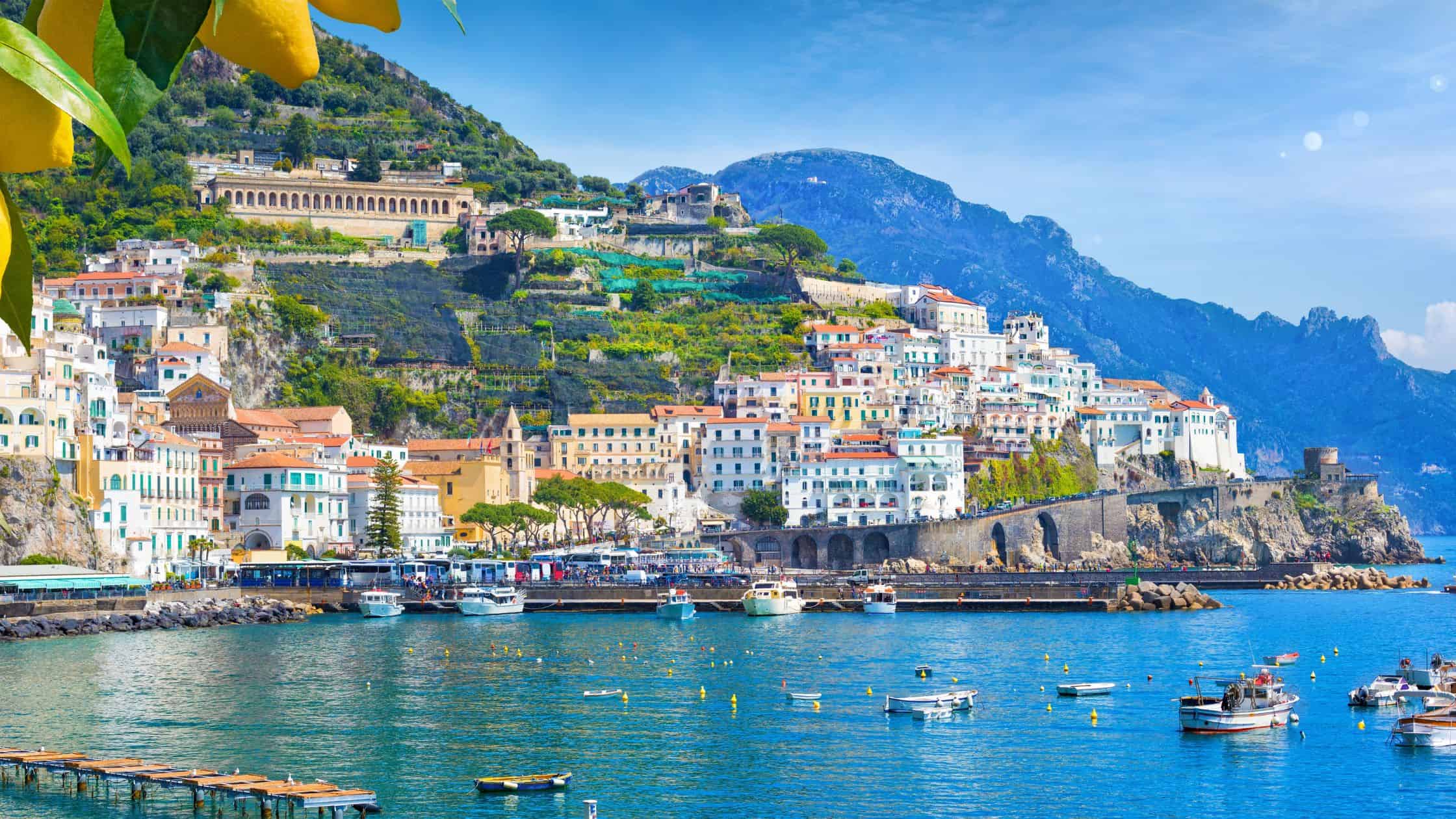
The Amalfi Coast is one of Italy’s most beloved and most spectacular regions: a 55-kilometre stretch of unbelievable coastal beauty that will have you feeling as though you walked onto the set of a movie. These are 11 of the prettiest Amalfi Coast towns and villages, each one offering its own unique blend of charm, history, and breathtaking scenery that is sure to have you completely spellbound:
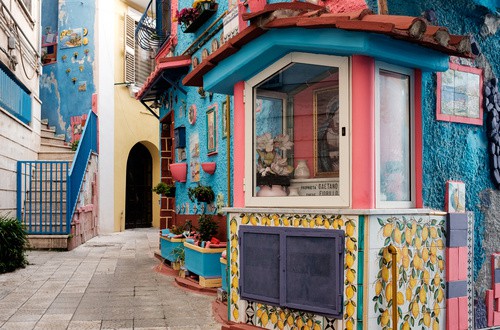
Vietri sul Mare, Amalfi Coast
The first Amalfi village you will encounter after leaving the city of Salermo, Vietri sul Mare is famous for its colourful, handmade ceramics, which make the ideal souvenir of an Amalfi holiday. Even the buildings are tiled with vibrant ceramic works of art, many of which feature the distinctive shade of lemon-yellow for which the region is renowned. A long stretch of sandy beach is the ideal spot to unwind: some sections offering free access while others are home to beach clubs that offer daybed and kayak hire.
Cetara is your go-to spot for a taste of authentic fishing village life, Amalfi style: a UNESCO World Heritage site where narrow, tunnel-like laneways lure you up the mountainside before suddenly revealing incredible views of the Tyrrhenian Sea. Down by the water, you can explore the charming harbour and watch fishermen at work, or head for the beach, where a 6th century watch tower stands guard over as you enjoy a dip. Follow the town’s main street, Corso Garibaldi, away from the beachfront to find a variety of open-air restaurants where you can indulge in the local delicacy, spaghetti alla colatura di alici, made with Cetara’s famous anchovy-based fish sauce. Consider joining an Italian cooking class and you’ll learn how to create all of the region’s most popular dishes at home, from eggplant parmigiana to sfogliatella pastries.
One of the most family-friendly towns in the region, Maiori is where you will find one of the Amalfi Coast’s most beautiful beaches: a kilometre-long stretch of sand, dotted with beach clubs where you can laze on a rented sun lounger in the shade of a beach umbrella. A long promenade with cafes, gelaterias and even a playground runs the length of the beach, which is overlooked at one end by a Norman tower and at the other by a fairytale castle, complete with pointy turrets and crenelated walls. The relatively flat terrain of the town is well suited to prams, strollers and those with mobility issues while still delivering the classic Amalfi combination of cobbled streets, ceramic-tiled buildings and incredible views of the Gulf of Salerno.
Connected to Maiori by the aptly named Sentiero dei Limoni (Path of the Lemons), Minori is a haven for lovers of all things citrus. The hillside between the two villages is filled with terraces of lemon groves, which are harvested to create the aromatic, lemon-based delights for which the Amalfi region is renowned, including the iconic limoncello liqueur. The three-kilometre walk can be completed in an hour or two, and on a hot day, there can be few more enjoyable rewards than treating yourself to a sweet, icy, zesty cup of lemon sorbet or granita, made fresh from locally sourced lemons.
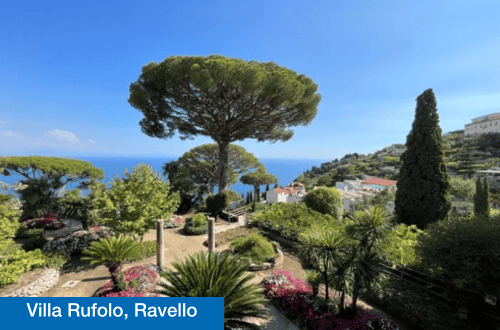
A few miles inland and high up in the mountains, Ravello is a haven of lush gardens and opulent villas that has inspired artists for centuries. The spectacular, hilltop Villa Cimbrone was once an eleventh-century manor but is now a luxury hotel that is renowned for its incredible views: even if your budget doesn’t stretch to a night’s accommodation here, its gardens and cloister are open to the public and well worth a visit. From here, it’s a short but lovely walk through the village to reach the Villa Rufolo: an equally beautiful Moorish-style villa whose terrace offers some of the most breathtaking views anywhere on the Amalfi Coast. Every summer, the village celebrates a famous nineteenth-century visitor to Villa Rufolo: the Wagner Festival (officially the Ravello Festival) originally focused solely on music by German composer Richard Wagner but now showcases a much wider programme of live music performances.
This hidden gem is much smaller than its more famous neighbours but is well worth a visit if you want to escape the crowds, especially during the peak summer months. It’s connected to the town of Amalfi by a short but spectacular clifftop walk, or you can save your legs by hopping aboard a local ferry or bus: once there, you’re free to explore its cobblestoned lanes and winding pathways to your heart’s content. Wander through tiny courtyards to reach a tiny, pebbled beach where you can enjoy the tranquil setting while relaxing on one of the many sun loungers available for hire.
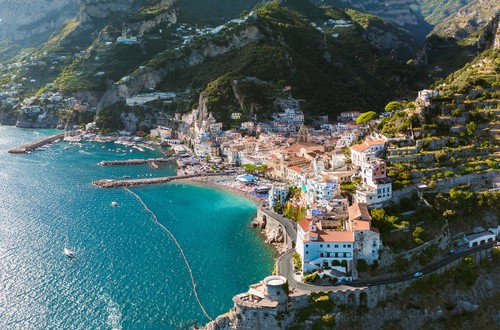
Aerial view of Amalfi Coast
Once a powerful centre of maritime trade, the Amalfi Coast’s namesake still offers an incredible mix of history and beauty: its historic cathedral, the Duomo di Sant’Andrea, has kept watch over the town and its inhabitants since the ninth century. Follow the town’s main street away from the Duomo, climbing ever upward towards the mountains, to find a variety of cafes and restaurants where you can sample the region’s iconic dishes – no visit to the Amalfi Coast would be complete without dining on locally caught seafood and locally grown lemons. Venture into the surrounding narrow streets and alleys and you’ll find yourself in a wonderland of hidden courtyards – the ideal spot for a restorative cup of Italian coffee to fuel your sightseeing activities.
This tiny seaside village, perched on the mountainside overlooking the scenic Amalfi Drive, is best known for its mesmerising Grotta dello Smeraldo, an incredible sea cave that gets its name from the emerald colour of its water as the sunlight filters through from outside. The cave’s existence was the stuff of rumour and myth for centuries before a local fisherman finally identified its location in 1932, becoming something of a local celebrity in the process. You can visit this enchanting underground wonderland by climbing the steep steps which lead down the cliff to its entrance, then boarding a small rowboat for a guided tour.
As you travel west along the Amalfi Drive, the road passes through a narrow tunnel that clings to the mountainside before emerging onto an arched stone bridge. From here, you can look down into the narrow depths and turquoise waters of the Furore Gorge, where a tiny swimming beach can be accessed on foot via a winding stone path: a dramatic quirk of nature that is a photographer’s dream. Higher up on the mountain, you’ll find terraces of houses and churches, vineyards and lemon orchards, as well as a colourful collection of murals that have transformed the town of Furore into an open-air art gallery.
The ‘Path of the Gods’ (Il Sentiero degli Dei) is an eight-kilometre stretch of hiking trail that winds its way along ancient mule routes and offers incredible panoramic views of the coastline and ocean beyond. The cutest village of Bomerano at the eastern end of the trail is one option for starting the trail: from here it’s a spectacular, at times vertiginous (and mostly downhill) journey to reach the equally scenic village of Nocelle at the other end. It’s a good idea to time your visit for spring or autumn if you’re planning to walk the trail but prefer to avoid the crowds and heat of high summer.
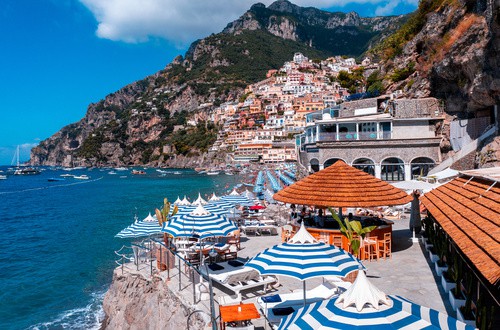
Positano, La Scogliera view
Linked to the village of Nocelle by yet another coastal hiking trail, Positano is one of the most glamorous towns on the Amalfi Coast, making it an ideal spot for people watching and boutique shopping. This postcard-worthy village sits nestled into the steep sea cliffs, and its colourful houses seem to defy gravity as they cascade down to the pebbled beach below. One of the town’s most iconic landmarks is the golden, tiled dome of the Church of Santa Maria Assunta, which houses a twelfth-century Byzantine icon of the Virgin Mary. Positano is also a popular location from which to visit Capri by boat; a visit to the famous Blue Grotto and a cable car ride to the top of Monte Solaro are essential if you are planning to experience this spectacular offshore island.
Exploring the enchanting twists and turns of the legendary Amalfi Drive is a must for anyone visiting the region. You have the choice of driving by car or Vespa, or you can opt for convenient public transport options like the Sita bus network or the local ferry service. Whether you choose to explore the Amalfi Coast by road, by boat or on foot, we recommend allowing at least three days to truly savour the experience – especially if you also want to visit Capri and Sorrento.
To plan your unforgettable Amalfi escape, talk to your personal travel manager today. Let us make your Amalfi Coast dreams come true!